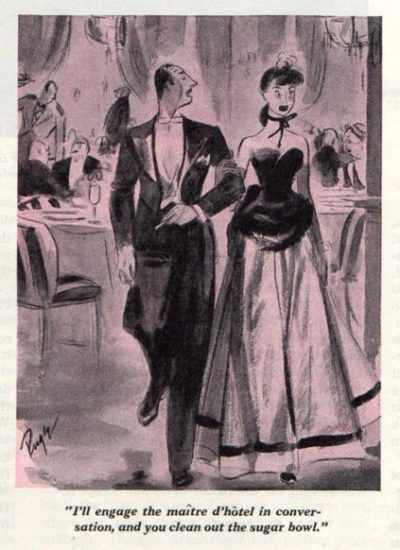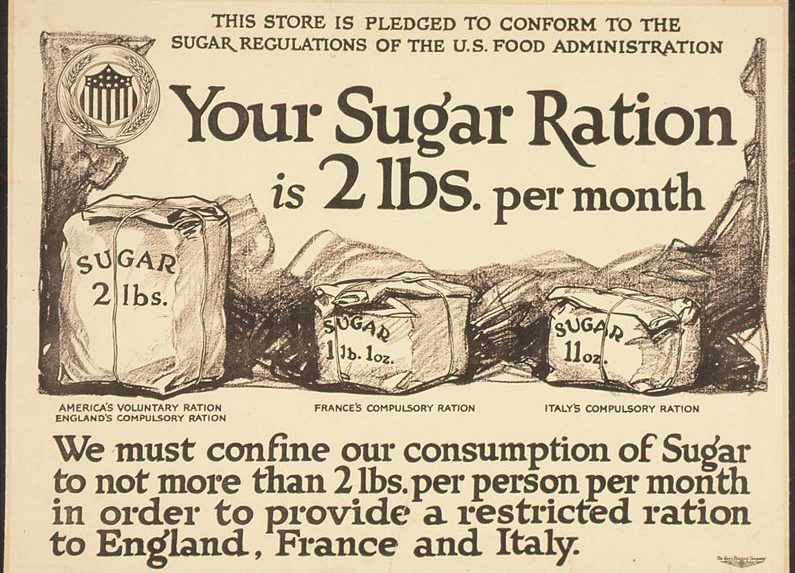 Life in America lost some of its sweetness in May of 1942. Not only was the country facing war with powerful enemies, but Americans had to cut their sugar consumption in half.
Life in America lost some of its sweetness in May of 1942. Not only was the country facing war with powerful enemies, but Americans had to cut their sugar consumption in half.
The U.S. no longer had access to the countries that had provided most of our sugar. Much of the remaining supply of sweetener was requisitioned by the War Department to ensure that America’s military personnel were well supplied. The U.S. Army, for example, provided its soldiers with more than twice the amount of sugar they had consumed as civilians. And still G.I.s craved more. A Navy study reported that when servicemen bought food to supplement their rations, 40% of their purchases were for candy.

Normally, shortages drive up retail prices until only the well-off can afford the in-demand item. To ensure Americans’ sacrifice was evenly distributed, the Office of Price Administration limited all consumer purchases of sugar.

Before rationing, Americans consumed on average about one pound of sugar every week. When homemakers were asked, pre-rationing, what was the least amount of sugar they would need to get by, their answers averaged to around 0.6 pounds a week. As it turned out, this was still more than what would become their wartime ration of a half-pound.
On April 27, 1942, all sales of sugar were halted. Grocers began selling sugar again on May 5, but only to customers who presented their new war-ration books. Provided the grocer even had sugar to sell, he would tear out the coupon valid for the current two-week period. The shopper would pay about 8¢ and receive one pound of sugar, his or her allotment for that 14-day period.
Every American — adults as well as children — received a ration book, so parents didn’t have to take from their rations to feed their children.
Not only did Americans learn to get by on less sugar, they endured the shortage for five years, including 22 months after the war ended.

Could Americans today cut their sugar intake in half? And just what is their annual consumption? It’s not easy to determine. Many of the sugars we consume occur naturally in our foods. So researchers tend to focus on added sweeteners refined from sugar cane, beets, and corn.
But even the added sweetener numbers vary. Estimates of annual consumption range from 70 pounds to 150 pounds a year.
Even going by more conservative numbers means Americans eat, on average, 22 teaspoons of added sugar every day. About 20% of Americans eat 48 teaspoons, or one cup, of sugar every day.
Promoting the benefits of better health has done little to reverse the consumption rate. According to Stephan Guyenet, even with our awareness of sugar’s contribution to obesity, heart disease, and diabetes, our sugar diet is headed in only one direction.
Featured image: U.S. National Archives
Become a Saturday Evening Post member and enjoy unlimited access. Subscribe now




Comments
Interesting article
it is very cool
Interesting article.My mom still has her hand-held mixer from 1956 that still works, and still has the 2 beaters that were inserted in the 2 holes on the bottom side.They look new.I have never bought sugar in any store. I don’t put any in coffee, tea, or on cereal.I don’t cook using any.Mom never buys any sugar either.What sugar I consume is already in the item.
Great article, Jeff. I think today all you can do is really try to be as conscious of sugar levels as you can and learn to say ‘no’ more to what we definitely know are sources of high sugar content. Stores like Sprouts have plenty of healthier alternative treats. Fresh fruit which seems obvious, is overlooked by many people.
I love the ads the POST ran during World War II, like this Sunbeam Mixmaster. It not only features the product, but how using it will help YOU help with the war effort. Most of the ads for nearly every product was tied in with the War.
My mother got a Mixmaster that still looked very much like this one (with the dials) as a wedding present in 1954, AND a hand-held Mixmaster Junior. If you held the small one upright, it looks a lot like a bomb that was dropped out many planes during World War II.
It still works as well today as it did back then. The only problem is finding new beaters for it. I need to look more diligently online with the serial/code #’s on the machine. Her 1954 GE electric iron still works great by the way. The cloth cord and plug were replaced in the ’90s. Oh, and it was made in Ontario, California in the U.S.A.